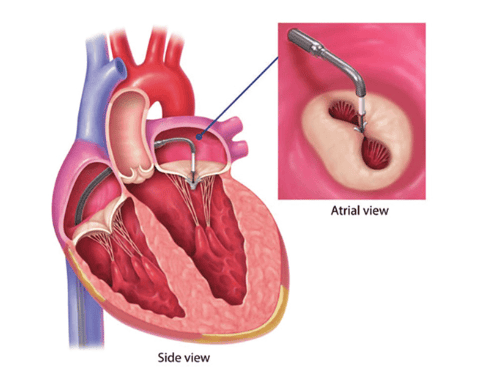This is an automatically translated article.
The article is professionally consulted by the Doctor of Cardiology Interventional Unit, Vinmec Times City International General Hospital.Mitral regurgitation is the most common pathology of heart valve diseases. The more valve regurgitation, the more severe the heart failure, the patient's fatigue and continuous shortness of breath. Therefore, early intervention, especially by non-surgical mitral valve repair, helps patients quickly recover their exercise capacity, reduce symptoms of heart failure, and improve quality of life. life in the long run.
1. What is mitral regurgitation?
The heart has a four-chamber structure, connected to each other and to the great arteries by four heart valves. In particular, the mitral valve is located on the left side, between the left atrium and the left ventricle. Since the left ventricle is the most important chamber of the heart, the main function of the heart is to pump blood throughout the body. Therefore, the mitral valve is always affected when the left heart fails. Therefore, secondary mitral regurgitation is the most common pathology among acquired valvular diseases.
Mitral regurgitation is a condition in which the heart valve does not close properly, causing blood to back up into the left atrium with each stroke. Since then, the amount of blood that needs to be ejected from the left ventricle to enter the general circulation is no longer guaranteed. This causes the heart to work harder, increasing the heart rate and also the strength of the heart muscle to contract. In the long term, the heart will fail, the chambers of the heart gradually dilate, leading to increased mitral regurgitation. At the same time, regurgitation causes the heart to fail even more, creating a vicious cycle. At this time, the patient needs to have surgical intervention to repair or replace the heart valve as soon as possible, to avoid permanent heart failure and loss of recovery ability.
2. Causes and consequences of mitral regurgitation?
Any disease affecting the left heart can cause mitral regurgitation. The most common condition is ischemic heart disease, a consequence of the long-term progression of atherosclerosis of the blood vessels that feed the heart. The blood supply to the heart is limited, leading to real cardiomyopathy in the long run, the heart dilates and leads to regurgitation. In addition, if the patient falls into an acute event of myocardial infarction, a necrotic area of the left heart, the muscle column, and the valvular ligament of the heart are broken, which also opens the valve leaflet. At the same time, the mitral valve can be open due to direct damage to the valvular apparatus such as mitral valve prolapse, valvular damage due to rheumatic fever, degeneration or post-infectious endocarditis, valve ligaments. Traumatically damaged heart, congenital heart disease, infiltrative cardiomyopathy, Marfan syndrome...
Whatever the cause of mitral regurgitation, the symptoms will vary depending on the degree of regurgitation. . Patients often have difficulty breathing when exerted or lying down, reduced exercise capacity, persistent dry cough, rapid heartbeat, leg edema, frequent urination at night...
Accordingly, if left for a long time without treatment, After treatment, the above symptoms will occur continuously, the patient has difficulty breathing even at rest, must sit or lie with his head high to breathe easily, affecting quality of life. Complications lead to heart failure, atrial fibrillation, increased risk of stroke, pulmonary hypertension, which in the long term can cause pulmonary edema or increase the risk of right heart failure.

Hở van tim 2 lá có thể dẫn đến nhiều biến chứng nguy hiểm như suy tim, đột quỵ,...
3. What is the non-surgical treatment of mitral regurgitation?
Previously, to repair the valve, doctors needed to perform open-heart surgery by cutting along the sternum, opening the thorax to repair, can sew the 2 edges of the valve to shape the number 8 or create an annular shape.. However, not everyone is suitable for surgery, there are many patients who are not healthy enough to endure the surgery, such as the elderly or people with other diseases, if surgery will be at risk. high risk of complications or death.
To overcome these limitations, scientists have successfully developed a new technique, called transcatheter mitral valve repair intervention with a device called MitraClip . This is considered a breakthrough in the treatment of mitral regurgitation.
The principle of operation of MitraClip is that through the catheter, a small clamp is passed from the femoral vein up to the heart. Observing on transesophageal echocardiography, the doctors clamped the mitral valve that was open when the heart was beating, creating a valve hole as shown in figure 8, significantly reducing the degree of valve regurgitation, preventing blood flow to the atria. left, helping the heart pump blood more efficiently. From there, the symptoms of heart failure will improve and preserve the patient's quality of life. During the procedure, the heart still works normally without the support from the heart-lung machines. Patients treated with MitraClip only spend an average of 3 days in the hospital, after which they can return to normal activities. Small wounds in the groin area will heal quickly, leaving no pain.
MitraClip has been widely used in the world to treat patients with inoperable mitral regurgitation. In Vietnam, a very few public cardiovascular centers are gradually applying and successfully implementing this method.

Mitra Clip là phương pháp kẹp 2 mép van tim bị hở thành hình số 8
4. Advantages of non-surgical treatment of mitral valve prolapse at Vinmec
According to one estimate in the world, one in 10 people over 75 years old will have mitral regurgitation. Although there is still no statistics on the number of patients with mitral valve prolapse in Vietnam, but with increasing life expectancy, the incidence of this disease in the elderly also increases. However, fewer and fewer patients are prescribed open-heart surgery, due to other chronic diseases, making it difficult to ensure health to undergo an open-heart surgery. That shows the increasing demand of applying advanced technology in the treatment of diseases for the elderly with the requirement of fast recovery time and suitable for their health condition. Devices developed based on scientific research such as MitraClip for mitral regurgitation in particular and other advanced interventional techniques in general can meet this requirement.

Can thiệp mạch tại Bệnh viện Đa khoa Quốc tế Vinmec
Along with major hospitals in Vietnam initially applying this technique, the Cardiovascular Center of Vinmec Health system has also been actively building technology and has achieved certain achievements from Mitra Clip. 2018 is an important milestone when Vinmec Times City Hospital first implemented the Mitra Clip technique. This patient is 55 years old, has a lot of mitral regurgitation, severe dilated heart chambers and difficulty breathing on exertion. After the intervention, the patient's quality of life was significantly improved. The left ventricular chamber is less dilated and close to normal, shortness of breath also decreases, the patient lives normally in the family. After that, many more patients were performed with a success rate equal to the world (95%), low complications (<5%) while the cost is very reasonable, lower than the general average. of Vietnam and the world
This has proven the ability to access and deploy modern and complex new techniques of Vinmec's team of cardiologists. In addition, it is necessary to recognize the smooth and effective coordination between specialized specialties in cardiovascular disease when working in groups, including cardiovascular clinicians, echocardiography, interventional cardiology, causing Anesthesiology and cardiovascular surgery, has contributed decisively to ensure the success of this very new technique in Vietnam and has been successfully applied at Vinmec.
Thanks to a large and methodical investment, in addition to Mitra Clip, Cardiovascular Center - Vinmec Hospital can also deploy many other difficult and complicated techniques at reasonable costs, providing comprehensive care for patients. Heart. From now on, when needed, the patient no longer has to undergo an open-heart surgery, the treatment process will be much lighter, from the hospital stay to the postoperative period is shortened but the treatment effect is still the same. as desired, especially the patient recovers very soon. In addition, coming to Vinmec, with the support of the information technology system, Vinmec doctors can monitor the patient's health after being discharged from the hospital methodically and thoughtfully and ensure advice and support as soon as needed. .
Please dial HOTLINE for more information or register for an appointment HERE. Download MyVinmec app to make appointments faster and to manage your bookings easily.













